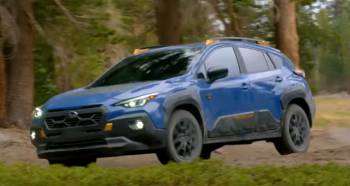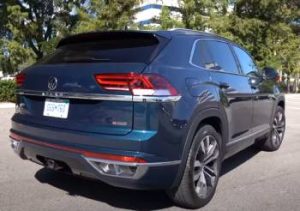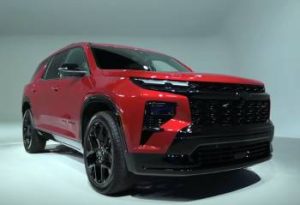Ah, the eternal debate—Honda CR-V or Subaru? For years, these automakers have been competing head-to-head, offering us top-notch SUVs that tick almost all the boxes.
But when it comes to putting your hard-earned cash on the line, you’ve gotta choose one, right? So, let’s do this. Buckle up!
A Brief Comparison Table
| Features | Honda CR-V | Subaru (Forester) |
| Base Engine | 1.5L turbocharged | 2.5L Boxer |
| Horsepower | 190 hp | 182 hp |
| Transmission | CVT | CVT |
| Drivetrain | FWD (optional AWD) | Standard AWD |
| Towing Capacity | Up to 1,500 pounds | Up to 1,500 pounds |
| Rear Legroom | More | Slightly less |
| Infotainment | User-friendly | Functional |
| Material Quality | Higher in upper trims | Durable |
| Ground Clearance | Lower | Higher |
| Standard Safety Features | Honda Sensing | EyeSight |
| Starting Price | Generally lower | Slightly higher |
Alright, folks, there you have it—the deep dive into what sets the Honda CR-V and Subaru apart. Each of these vehicles has its own set of pros and cons, so your choice boils down to what suits your lifestyle the best. Now, go on and make that choice, because either way, you’ll be cruising in style.
Performance: Rev Those Engines

Honda CR-V
The Honda CR-V brings a smooth performance to the table. With its 1.5-liter turbocharged four-cylinder engine, you get a nifty balance of power and fuel efficiency. For most drivers, the CR-V delivers the power needed for daily tasks like grocery runs, soccer practice, and those weekend road trips.
Pros:
- Seamless CVT (Continuously Variable Transmission)
- Good fuel efficiency
- Comfortable driving experience
Cons:
- Somewhat less engaging for spirited drivers
- Limited engine choices
Subaru
Subaru is famous for its Boxer engine and standard all-wheel drive (AWD) across most of its lineup, including the Forester, which is Subaru’s answer to the Honda CR-V. This standard AWD gives you superior traction, particularly useful for those who live in snow-prone areas.
Pros:
- Standard AWD
- Greater off-road capability
- Sportier handling
Cons:
- A bit less fuel-efficient than the CR-V due to the AWD
- The CVT is less refined compared to Honda
Also Read: Differences Between Green And Gray Tint Privacy.
Interior: Comfort or Functionality?

Honda CR-V
The Honda CR-V’s interior is designed for comfort. With its spacious rear legroom, adults can actually sit comfortably in the backseat. Plus, Honda’s infotainment system is generally more user-friendly.
Pros:
- Ample cargo space
- User-friendly tech features
- Premium materials in upper trims
Cons:
- Limited customization options
Subaru
Subaru, on the other hand, is a bit more rugged. It’s got a spacious interior, but it leans more towards functionality than luxury. Cargo space is almost as good as the CR-V, but what sets it apart is the more durable material—great for your adventurous lifestyle.
Pros:
- More rugged interior materials
- Good cargo space
- Functional design
Cons:
- Less luxurious feel
- Infotainment system could be better
Safety Features: Buckle Up, Buttercup
Both Honda and Subaru have excellent reputations for safety. The CR-V comes with Honda Sensing, a suite of advanced safety features, while Subaru’s EyeSight tech also brings an array of safety aids. Really, you can’t go wrong with either in terms of safety.
Honda CR-V Pros:
- Great crash test ratings
- Comprehensive Honda Sensing suite
Subaru Pros:
- Standard AWD increases traction
- Excellent crash test scores
Cons for Both:
- Advanced features often require upper trims
Key Differences Between Honda CR-V and Subaru: The Nitty-Gritty
Ah, so you’re still torn between the Honda CR-V and Subaru, aren’t you? No worries—let’s dig deeper into the differences that really set these two apart.
Powertrain and Performance: Torque vs Traction
Honda CR-V
The Honda CR-V features a 1.5-liter turbocharged four-cylinder engine that puts out 190 horsepower. Coupled with a refined CVT, the driving experience is smooth and efficient.
Honda CR-V Key Features:
- 1.5L turbocharged engine with 190 hp
- CVT (Continuously Variable Transmission)
- FWD with optional AWD
- Towing capacity of up to 1,500 pounds
Subaru (Forester)
Subaru’s lineup, including the Forester, comes standard with a 2.5-liter Boxer four-cylinder engine that outputs 182 horsepower. One of the most significant differences is Subaru’s Symmetrical All-Wheel Drive, which is standard.
Subaru Key Features:
- 2.5L Boxer engine with 182 hp
- Standard Symmetrical All-Wheel Drive
- Slightly lower towing capacity, typically around 1,500 pounds
The real decision here boils down to whether you prioritize fuel efficiency and a smooth ride (Honda CR-V) or superior traction and off-road capabilities (Subaru).
Interior Amenities: Convenience vs Utility
Honda CR-V
The CR-V’s interior comes with features that make your life easier. A high-quality infotainment system, plush seating, and spacious cabin are just a few of the perks.
Honda CR-V Key Features:
- More rear legroom
- Android Auto and Apple CarPlay available
- Premium materials in higher trims
- Optional wireless phone charger
Subaru (Forester)
The Forester is rugged and functional, with a focus on utility. You get standard features like Android Auto and Apple CarPlay, but the material choices are more durable than luxurious.
Subaru Key Features:
- Durable cloth seats in standard trims
- Slightly less rear legroom
- Higher ground clearance for off-road adventures
- Ample cargo space, comparable to the CR-V
Again, if you want a more luxurious feel, Honda CR-V is your go-to. But for a more rugged experience, especially if you’re an outdoorsy type, Subaru wins hands down.
Technology: User-Friendly vs Functional
Honda CR-V
Honda’s infotainment system is generally more user-friendly with a cleaner interface. Higher trims come with features like a 7-inch Display Audio touchscreen and a premium sound system.
Subaru (Forester)
Subaru’s infotainment system is functional but not as intuitive as Honda’s. However, Subaru has made improvements in recent models, offering a decent tech experience, especially in the higher trims.
Safety Features: Who Wins?
Both Honda and Subaru prioritize safety. But while Honda’s advanced suite, Honda Sensing, is highly praised for features like Collision Mitigation Braking and Lane Keeping Assist, Subaru’s EyeSight technology counters with Adaptive Cruise Control and Pre-Collision Braking. Both have excellent crash test ratings, so it’s tough to declare a definitive winner here.
Price: Budget-Friendly vs Value-for-Money
Honda CR-V
Starting prices for the CR-V are generally a bit lower, making it more budget-friendly upfront. However, higher trims can get a bit pricey, especially when you start adding optional features.
Subaru (Forester)
While Subaru might come with a slightly higher base price, remember that it includes standard AWD, which is an optional (and costly) addition for the CR-V. The Forester offers a bit more value-for-money if you consider the standard features it offers.
Also Read: Differences Between Avery Dennison And XPEL PPF.
FAQs: Clearing Up Some Common Queries
This is subjective and depends on what you’re looking for. Subaru offers superior off-road capabilities with its standard AWD, while Honda focuses on comfort and smooth driving.
Both brands have strong reputations for reliability. Honda has a longer history, but Subaru’s engines are also well-built. It’s a toss-up, honestly.
The Subaru Forester is the closest equivalent to the Honda CR-V. Both are compact SUVs aimed at similar markets.
Both the Honda CR-V and Subaru Forester have excellent reliability records. Your choice may depend on other factors like performance, interior quality, or safety features.
Both brands have excellent safety features and great crash test ratings. It’s hard to declare one as safer than the other. Subaru’s AWD does offer better traction, which might be a plus in bad weather.
Again, both brands are strong in safety. However, Honda’s upper trims offer a slightly more advanced safety suite, which could tip the scale for some buyers.
The Final Lap
So, there you have it—the ultimate showdown between Honda CR-V and Subaru. Whichever you choose, you’re likely to end up with a reliable, comfortable, and safe ride. But hey, your choice will ultimately depend on what ticks more of your boxes—whether it’s off-road adventures or simply a comfy daily driver.
Remember, the road is long, and both Honda and Subaru are well-equipped to take you where you want to go. Happy driving!



